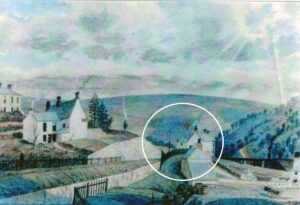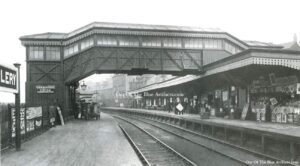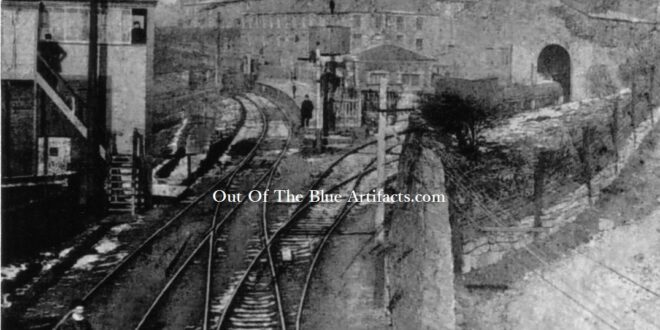Abertillery Railway Stations.
In the 1830’s – 1840’s the old tram road from Newport to Nantyglo passed through Abertillery. The town of Abertillery was undeveloped at this time with no major infrastructure, though when the Abertillery Iron Works of Richard Walker was established and began producing, there must have been some sort of siding on the tramline to transport the products from the works.
 The First Station.
The First Station.
The water colour (as seen left) from 1857 (looking south), shows the back of the Bush Inn (seen left in the image, left) with Pond House and platform station (circled). The tram road is seen going up the valley (bottom left).
When the Abertillery Iron Works closed and were transformed into a tin works by Messrs J. Conway and J. Pearce in the late 1840’s they constructed a railway platform with a post office attached. This platform was to enable the unloading and loading of goods, machinery and equipment for the works and later for the town.
Mr George Jones.
The first station master at Abertillery was Mr George Jones. He and his wife more than probably lived in one of the houses located by Pond House. In the 1851 census the Jones family are listed as being in that vicinity.
Mr Frederick Morgan Woodcock.
During the late 1850’s Mr Frederick Morgan Woodcock was station master at the Abertillery Station.
The Second Station.
Not long after, as the industry in Abertillery expanded and the population grew, a new railway station was erected and laid out. This new station was where the library is today (as seen in the main featured photograph above). The railway line was routed in front of the Lymes House and close to the Station Hotel with a level-crossing at the junction of Station Hill.
Mr William Mogford.
In 1863 Mr William Mogford began his duties as station master at Abertillery.
Mr Joseph Reuben Leech.
In 1885 Mr Joseph Reuben Leech became the station master at Abertillery.
The Third Station.
In December 1890 the new Railway Station at Abertillery was opened. It was a major construction scheme, along with the new station the railway lines were swung out to the West from under a new road bridge at the Bush Inn, to behind the Lymes House re-routed away from the Station Hotel over a road bridge (that had to be built on a large man-made embankment) to do away with the dangerous level-crossing and back to its original route a few hundred yards north of the new station. All this was done without delays or disruption to the railway traffic through the valley.
 On Sunday 7th December 1890 the new station was used for the first time, after the morning down train had passed, a large crew were dispatched to make the new connections in time for the 6.33am train to arrive. People had walked to Aberbeeg for the purpose of riding in on that first train. It was reported that Oak Street was full of spectators.
On Sunday 7th December 1890 the new station was used for the first time, after the morning down train had passed, a large crew were dispatched to make the new connections in time for the 6.33am train to arrive. People had walked to Aberbeeg for the purpose of riding in on that first train. It was reported that Oak Street was full of spectators.
Mr J. Edmunds.
In 1899 Mr J. R. Leech left Abertillery and Mr J. Edmunds took over as station master for a short while.
Mr Albert Webber.
In the 1900’s up until the 1920’s the station master was Mr Albert Webber.
Mr John Davies.
Mr Webber was succeeded by Mr John Davies.
(Later information to come).
The Withdrawal of Train Services in the Valleys.
On Friday 6th of April 1962, the Coventry Evening Telegraph was one of a few newspapers that issued notices of the forthcoming announcement that the passenger trains of the British Railways in the Eastern and Western Valley’s of Monmouthshire are to be withdrawn on and from Monday 30th of April 1962. Thirty-seven stations will close to passengers on that date.
The Last Passenger Train at Abertillery.
On Friday 4th of May 1962, the South Wales Gazette reported on the last passenger train that left the Abertillery Railway Station. On the previous Sunday night, the 29th of April 1962 at 10.30pm, fewer than a dozen passengers at Abertillery saw the end of the Western Valley service. The train had come from Blaina and finished its journey at Aberbeeg at 10.46pm. It was reported that four stations will be closed as a result of the withdrawal of services – Nantyglo, Bournville, Six Bells and Llanhilleth. Parcel facilities will be available at Blaina, Abertillery and Aberbeeg with parcels being collected by lorry on request.
The Closure of the Abertillery Railway Station.
After the station closed to the public in the early 1960’s, it was demolished and the site cleared. The line was kept open for coal transportation from the Rose Heyworth Colliery. The Cwmtillery branch line was closed along with the junction signal box.
In 1983 the site of the old station was used by the Abertillery Market Traders and did a good trade, though in 1986 the Rose Heyworth Colliery closed and the new road the A467 was constructed up through the site. The road layout used the old railway line from this point all the way to Brynmawr. The old Lymes Club, embankments, road bridges and the Bush Hill bridge were all flattened or graded to make the area suitable for the approach for the new road.
 Out Of The Blue Artifacts A Library of a lifetime of collecting
Out Of The Blue Artifacts A Library of a lifetime of collecting
